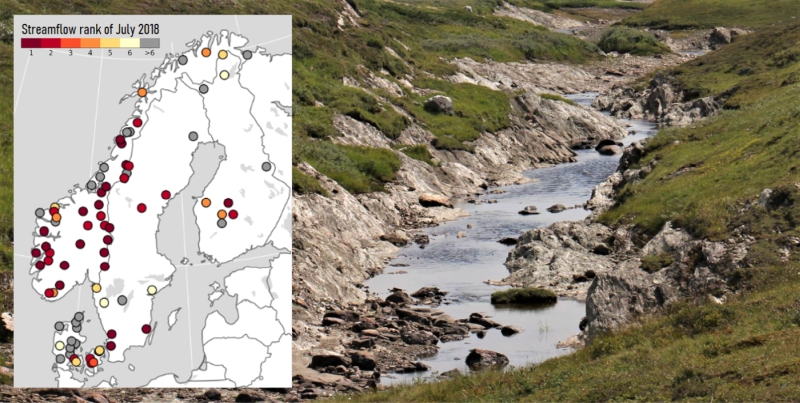The PhD defence and trial lecture will be held in Auditorium 1, The Geology Building. In some cases, it will be possible to attend the trial lecture and dissertation digitally, in that case a link to Zoom will be posted.
Trial lecture
Wednesday 28 June, 10:15-11:00, Aud 1, The Geology Building
Using nature to combat drought impact
Conferral summary (in Norwegian)
Tørke er en naturfare som kan ramme store områder og medføre en rekke konsekvenser for natur og samfunn. I avhandlingen beskrives ulike aspekter ved nylige tørkefenomener i Europa, med et hovedfokus på 2018-tørken. Høytrykksystemene og temperaturene var rekordhøye over Nord-Europa i mai og juli 2018, noe som i kombinasjon med mangel på regn, førte til meteorologisk tørke fra mai og hydrologisk tørke fra juni. Avhandlingen viser at hydrologisk tørke og skogbranner i regionen må ses i sammenheng med både meteorologiske forhold, lokale prosesser og om området har et vått eller tørt utgangspunkt.
Main research findings
Popular scientific article about Jørgensen Bakke’s dissertation:
Recent European warm-season droughts: drivers, extremeness and impacts – With a special focus on the 2018 drought in northern Europe
Recent droughts in Europe have led to high costs and severe impacts. To be better prepared for such major events in the future, we need to improve our understanding of how these multifaceted events develop. My thesis place recent droughts in Europe in a historical perspective, and looks at relations between different aspects of drought (drivers, characteristics and impacts). A particular focus is on the major 2018 drought.
This event was unique in its northern location of record-breaking high-pressure systems, record-breaking high temperatures, precipitation deficits and meteorological drought. In the Nordic region, extremely low streamflow and groundwater levels (hydrological drought) developed over the summer. The hydrological drought was delayed compared to the meteorological drought, and showed a mixed spatial pattern that reflects various local processes and hydrological preconditions. An unusually large number of wildfires was seen in Fennoscandia in 2018, connected to high monthly fire danger following soil moisture deficits and high temperatures.
Another extreme drought hit Europe in 2022, again illustrating the strong link between droughts and prevailing high-pressure systems. Current climate models are not able to satisfactory represent changes in atmospheric pressure, implying high uncertainties in future projections.

Photo and other information:
Press photo: Sigrid Jørgensen Bakke, portrait; 500px. Photo: Private
Other photo material: Figure with description and credit as specified in the article above, size 1400px.
An article about her research can be read at titan.uio.no (in Norwegian):
- Hvis det først blir tørt, kan det bli langvarig, titan.uio.no, 7.6.2023.
